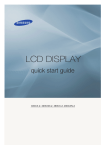Download Samsung 34Z7 CRT Television User Manual
Transcript
LCD MONITOR
quick start guide
400CX , 460CX
ii
Introduction
Package Contents
Note
Please make sure the following items are included with your LCD Display.
If any items are missing, contact your dealer.
Contact a local dealer to buy optional items.
Note
This stand is not for the Floor Standing Type.
Unpacking
LCD Display
Manuals
Quick Setup Guide
Warranty Card
(Not available in all locations)
Cables
D-Sub Cable
Others
Power Cord
User's Guide
Introduction
Others
Remote Control
Batteries (AAA X 2)
Cleaning Cloth
(Not available in all locations)
HDD Cover
Sold separately
DVI Cable
Wall Mount KIT
Semi Stand KIT
Note
Cleaning Cloth is only provided for highly polished black products as a product feature.
Your LCD Display
Front
MENU button [MENU]
Opens the on-screen menu and exits from the menu. Also use to exit the OSD menu
or return to the previous menu.
Navigate buttons (Down-Up buttons) / Channel buttons
Moves from one menu item to another vertically or adjusts selected menu values.
Introduction
When OSD is not on the screen, push the button to adjust channel.
Adjust buttons (Left-Right buttons) / Volume buttons
Moves from one menu item to another horizontally or adjusts selected menu values. When OSD is not on the screen, push the button to adjust volume.
ENTER button [ENTER]
Activates a highlighted menu item.
SOURCE button [SOURCE]
Switches from PC mode to Video mode. Changing the source is only allowed for
external devices that are connected to the LCD Display at the time.
[PC] → [DVI] → [AV] → [HDMI] → [TV]
D.MENU
Opens the on-screen D.MENU.
Power button [
]
Use this button for turning the LCD Display on and off.
Brightness Sensor
The product's Brightness Sensor function automatically detects the surrounding
brightness using a brightness sensor and adjusts its brightness accordingly.
Power indicator
Shows PowerSaver mode by blinking green
Note
See PowerSaver described in the manual for further information regarding power
saving functions. For energy conservation, turn your LCD Display OFF when it
is not needed or when leaving it unattended for long periods.
Remote Control Sensor
Aim the remote control towards this spot on the LCD Display.
Rear
Note
For detailed information concerning cable connections, refer to Connecting Cables under Setup. The
LCD Display 's configuration at the back may vary slightly depending on the LCD Display model.
Introduction
POWER S/W ON [ │ ] / OFF [O]
Switches the LCD Display On/Off.
POWER IN
The power cord plugs into the LCD Display and
the wall plug.
RS232C OUT/IN (RS232C Serial PORT)
MDC(Multiple Display Control) Program Port
DVI / PC / HDMI IN [DVI/PC/HDMI AUDIO
IN] (PC/DVI/HDMI Audio Connection Terminal
(Input))
DVI / PC / HDMI IN [HDMI]
Connect the HDMI terminal at the back of your
LCD Display to the HDMI terminal of your digital output device using a HDMI cable.
DVI / PC / HDMI IN [RGB](PC Video Connection Terminal)
Using a D-Sub Cable (15 pin D-Sub) - PC mode
(Analog PC)
DVI / PC / HDMI IN [DVI] (PC Video Connection Terminal)
Using a DVI Cable (DVI-D to DVI-D) - DVI
mode (Digital PC)
Introduction
DC OUT [5V/1.5A]
Connect this to the POWER connector of a TV
tuner box or network box.
AV IN [VIDEO] (VIDEO Connection Terminal) Connect the [VIDEO]
terminal of your monitor to the video output terminal of the external device using a VIDEO cable.
AV AUDIO IN [L-AUDIO-R](LCD Display
Audio Connection Terminal (Input))
AUDIO OUT [L-AUDIO-R] (LCD Display
Audio Connection Terminal (Output))
COMMON INTERFACE
This contains information on CAM inserted in the
CI slot and displays it.
When not inserting CI CARD in some channels,
Scramble Signal is displayed on the screen.
You can install the CAM anytime whether the TV
is ON or OFF.
ANT IN
Connect the CATV cable or TV antenna cable to
the " ANT IN" port on the rear side of the LCD
Display. Make sure to use a TV antenna cable
(sold separately) as the antenna cable.
Introduction
Kensington Lock
The Kensington Lock is a device used to physically fix the system when using it in a public
place. The locking device has to be purchased
separately. The appearance and locking method
may differ from the illustration depending on the
manufacturer. Refer to the manual provided with
the Kensington Lock for proper use. The locking
device has to be purchased separately.
Note
The location of the Kensington Lock may be different depending on its model.
Using the Anti-Theft Kensington Lock
1.
Insert the locking device into the Kensington
slot on the LCD Display
the locking direction
and turn it in
.
2.
Connect the Kensington Lock cable.
3.
Fix the Kensington Lock to a desk or a heavy
stationary object.
Note
See Connecting Cables for further information regarding cable connections.
Remote Control
Note
The performance of the remote control may be affected by a TV or other electronic device operating
near the LCD Display , causing a malfunction due to interference with the frequency.
Introduction
POWER
OFF
Number Buttons
DEL
button
+ VOL MUTE
TV/DTV
MENU
INFO
COLOR BUTTONS
TTX/MIX
STILL
AUTO
S.MODE
MDC
LOCK
SOURCE
ENTER/PRE-CH
CH/P
D.MENU
GUIDE
RETURN
Up-Down Left-Right buttons
EXIT
SRS
MagicInfo
P.MODE
DUAL/MTS
PIP
SWAP
1.
POWER
Turns the product On.
2.
Off
Turns the product Off.
3. Number Buttons
Press to change the channel.
Introduction
4. DEL
button
The "-" button operates only for DTV. It is used to select MMS
(multi-channel) for a DTV.
5. + VOL -
Adjusts the audio volume.
6.
Pauses (mutes) the audio output temporarily. This is displayed on
the lower left corner of the screen. The audio resumes if MUTE
or - VOL + is pressed in the Mute mode.
MUTE
7. TV/DTV
Selects the TV and DTV mode directly.
8. MENU
Opens the on-screen menu and exits from the menu or closes the
adjustment menu.
9.
Activates a highlighted menu item.
10.
INFO
Current picture information is displayed on the upper left corner
of the screen.
11.COLOR BUTTONS
Press to add or delete channels and to store channels to the favorite
channel list in the “Channel List” menu.
12.
TV channels provide written information services via teletext.
TTX/MIX
- Teletext Buttons
For more information > TTX / MIX
13.STILL
Press the button once to freeze the screen. Press it again to unfreeze.
14.AUTO
Adjusts the screen display automatically in PC mode. By changing
the resolution in the control panel, auto function is performed.
15. S.MODE
When pressing this button, the current mode is displayed at the
bottom centre of the screen. The LCD Display has a built-in high
fidelity stereo amplifier. Then press the button again to circle
through available preconfigured modes. ( Standard → Music
→ Movie → Speech → Custom )
16.MDC
MDC Quick Launch Button.
17.LOCK
Activates or deactivates all function keys on both the remote control and the LCD Display except for the Power and LOCK buttons.
18.
Press the button to change the input signal SOURCE.
SOURCE
Changing the SOURCE is only allowed for external devices that
are connected to the LCD Display at the time.
19.
ENTER/PRE-CH
This button is used to return to the immediately previous channel.
20. CH/P
In TV mode, selects TV channels.
21.D.MENU
DTV menu display
22.GUIDE
Electronic Program Guide (EPG) display.
23.
Returns to the previous menu.
RETURN
Introduction
. Up-Down Left-Right buttons
Moves from one menu item to another horizontally, vertically or
adjusts selected menu values.
25.
EXIT
Exits from the menu screen.
26.
SRS
SRS TS XT
27.MagicInfo
This fuction does not work for this LCD Display.
28. P.MODE
When you press this button, current picture mode is displayed on
the lower center of the screen.
AV / HDMI / TV : P.MODE
The LCD Display has four automatic picture settings that are preset at the factory. Then push button again to circle through available preconfigured modes. ( Dynamic → Standard → Movie
→ Custom )
PC / DVI / MagicInfo: M/B (MagicBright)
MagicBright is a feature providing the optimum viewing environment depending on the contents of the image you are watching.
Then push button again to circle through available preconfigured
modes. (Entertain → Internet → Text → Custom )
29.
DUAL/MTS
DUALSTEREO/MONO, DUAL l / DUAL ll and MONO/NICAM
MONO/NICAM STEREO can be operated depending on the
broadcasting type by using the DUAL button on the remote control
while watching TV.
MTSYou can select MTS (Multichannel Television Stereo) mode.
FM Stereo
30. PIP
Audio Type
MTS/S_Mode
Default
Mono
Mono
Manual Change
Stereo
Mono ↔ Stereo
SAP
Mono ↔ SAP
Mono
Every time you press the button, a PIP screen appears.
- This fuction does not work for this LCD Display.
31.SWAP
Swaps the contents of the PIP and main image. The image in the
PIP window will appear on the main screen, and the main screen
image will appear in the PIP window.
- This fuction does not work for this LCD Display.
Mechanical Layout (400CX)
Mechanical Layout
Connections
Connecting a Computer
Using a Power cord with Earth
•
In the event of failure, the earth lead may cause electric shock. Make sure to
wire the earth lead in correctly, before connecting the AC power. When unwiring the earth lead, make sure to disconnect the AC power in advance.
Note
AV input devices such as DVD players, VCRs or camcorders as well as your computer can be connected
to the LCD Display. For detailed information on connecting AV input devices, refer to the contents
under Adjusting Your LCD Display.
Connect the power cord for your LCD Display to the power port on the back of
the LCD Display. Trun on the power switch.
There are 2 ways to connect the D-sub to your LCD Display. Choose one of the
following:
Using the D-sub (Analog) connector on the video card.
•
Connect the D-sub to the 15-pin, RGB port on the back of your LCD Display
and the 15 pin D-sub Port on the computer.
Using the DVI (Digital) connector on the video card.
•
Connect the DVI Cable to the DVI(HDCP) port on the back of your LCD
Display and the DVI port on the computer.
Connections
Connect the audio cable for your LCD Display to the audio port on the back of
your computer.
Note
•
Turn on both your computer and the LCD Display.
•
The DVI cable is optional.
•
Contact a local SAMSUNG Electronics Service Center to buy optional items.
Connecting to Other devices
Using a Power cord with Earth
•
In the event of failure, the earth lead may cause electric shock. Make sure to
wire the earth lead in correctly, before connecting the AC power. When unwiring the earth lead, make sure to disconnect the AC power in advance.
Note
AV input devices such as DVD players, VCRs or camcorders as well as your computer can be connected
to the LCD Display. For detailed information on connecting AV input devices, refer to the contents
under Adjusting Your LCD Display.
Connecting TV
Note
You may view television programs on the LCD Display if it is connected to an antenna or CATV cable
without installing any separate TV reception hardware or software on your computer.
1.
Connect the CATV cable or TV antenna cable to the "ANT IN" port on the rear side of the LCD
Display.
Make sure to use a TV antenna cable (sold separately) as the antenna cable.
•
When using an interior antenna terminal:
Check the antenna terminal on the wall first and connect the antenna cable.
Connections
•
When using an outdoor antenna:
If you are using an outdoor antenna, use a professional for installation if possible.
•
To connect the RF cable to the antenna input terminal:
Keep the copper wire portion of the RF cable straight.
2.
Turn on the LCD Display.
3.
Select TV using the TV / DTV.
4.
Select a desired TV channel.
Note
Is weak signal causing poor reception?
Purchase and install a signal amplifier for better reception.
Connecting COMMON INTERFACE
Note
You can install the CAM anytime whether the TV is ON or OFF.
Purchase the CI CAM module by visiting your nearest dealer or by phone.
1.
Insert the CI CARD into the CAM in the direction of the arrow until it fits.
2.
Insert the CAM with the CI CARD installed into the common interface slot.
(Insert the CAM in the direction of the arrow, right up to the end so that it is parallel with the
slot.)
3.
Check if you can see a picture on a scrambled signal channel.
Connecting AV Devices
Connections
1.
Connect the port of the DVD, VCR (DVD / DTV Set-Top Box) to the [R-AUDIO-L] port of the
LCD Display.
2.
Then, start the DVD, VCR or Camcorders with a DVD disc or tape inserted.
3.
Select AV using the SOURCE .
Note
The LCD Display has AV connection terminals to connect AV input devices like DVDs, VCRs or
Camcorders. You may enjoy AV signals as long as the LCD Display is turned on.
Connecting to a Camcorder
1.
Locate the AV output jacks on the camcorder. They are usually found on the side or back of the
camcorder. Connect a set of audio cables between the AUDIO OUTPUT jacks on the camcorder
and the AV AUDIO IN [L-AUDIO-R] on the LCD Display.
2.
Connect a video cable between the VIDEO OUTPUT jack on the camcorder and the AV IN
[VIDEO] on the LCD Display.
3.
Select AV for the Camcorder connection using the Source button on the front of the LCD Display
or on the remote control.
4.
Then, start the Camcorders with a tape inserted.
Note
The audio-video cables shown here are usually included with a Camcorder. (If not, check your local
electronics store.) If your camcorder is stereo, you need to connect a set of two cables.
Connecting Using a HDMI Cable
Note
•
Input devices such as digital DVD are connected to the HDMI terminal of the LCD Display using
the HDMI cable.
Connections
•
You cannot connect a PC to the HDMI terminal.
Connecting Using a DVI to HDMI Cable
Note
•
Connect the DVI output terminal of a digital output device to the HDMI terminal of the LCD
Display using a DVI to HDMI cable.
•
Connect the red and white jacks of an RCA to stereo (for PC) cable to the same colored audio
output terminals of the digital output device, and connect the opposite jack to the HDMI / PC /
DVI-D AUDIO IN terminal of the LCD Display.
Connecting to an Audio System
Note
•
Connect a set of audio cables between the AUX L, R jacks on the AUDIO SYSTEM and AUDIO
OUT [L-AUDIO-R] on LCD Display.
Using the HDD Cover
You can install an external 2.5" USB hard disk.
Connections
1.
Insert
into the groove at the top of
, and then place and press
into the groove at the
bottom
of . The USB cable of the external hard disk can be connected via the
the USB connector of the monitor.
2.
Check whether the parts are fixed correctly.
Note
•
When removing the HDD Cover, pull the
part slightly.
part to
Troubleshooting
Self-Test Feature Check
Note
Check the following items yourself before calling for assistance. Contact a Service Center for problems
that you cannot solve by yourself.
Self-Test Feature Check
1.
Turn off both your computer and the LCD Display.
2.
Unplug the video cable from the back of the computer.
3.
Turn on the LCD Display.
The figure shown below ("Check Signal Cable") appears on a black background when the LCD
Display is working normally even though no video signal is detected: While in the Self-Test mode,
the LED power indicator remains green and the figure moves around on the screen.
4.
Turn off your LCD Display and reconnect the video cable; then turn on both your computer and
the LCD Display
If your LCD Display screen remains blank after using the previous procedure, check your video controller and computer system; your LCD Display is functioning properly.
Warning Messages
You can even view the screen at a resolution of 1360(1920) x 768(1080). However, you will receive
the following message for a minute; You can choose to change the screen resolution or stay in the
current mode during that time. And if the resolution is more than 85Hz, you will see the black screen
because the LCD Display does not support over 85Hz.
Note
Refer to Specifications > Preset Timing Modes for the resolutions or frequencies supported by the
LCD Display.
Maintenance and Cleaning
1) Maintaining the LCD Display Case.
Clean with a soft cloth after disconnecting the power cord.
Troubleshooting
•
Do not use benzene, thinner or other flammable substances, or a wet cloth.
•
We recommend that a SAMSUNG cleansing agent is used
to prevent damage to the screen.
2) Maintaining the Flat Panel Display Screen.
Clean with a soft cloth (cotton flannel) smoothly.
•
Never use acetone, benzene or thinner.
(They may cause flaws or deformation of the screen surface.)
•
The user will be required to pay costs and related expenses
for repairing damages caused.
Symptoms and Recommended Actions
Note
A LCD Display recreates visual signals received from the computer. Therefore, if there is a problem
with the computer or the video card, this can cause the LCD Display to become blank, have poor
coloring, become noisy, and video mode not supported, etc. In this case, first check the source of the
problem, and then contact a Service Center or your dealer.
1.
Check if the power cord and the video cables are properly connected to the computer.
2.
Check if the computer beeps more than 3 times when booting.
(If it does, request an a service for the main board of the computer.)
3.
If you installed a new video card or if you assembled the PC, check if you installed the Adaptor
(video).
4.
Check if the scanning ratio of the video screen is set to between 50 Hz ~ 85 Hz.
(Do not exceed 60Hz when using the maximum resolution.)
5.
If you have problems in installing the Adaptor (video) driver, boot the computer in Safe Mode,
remove the Display Adaptor in the "Control Panel -> System -> Device Administrator" and then
reboot the computer to reinstall the Adaptor (video) driver.
Check List
Note
•
The following table lists possible problems and their solutions. Before calling for assistance, check
the information in this section to see if you can remedy any problems for yourself. If you do need
assistance, please call the phone number on the Information section or contact your dealer.
Problems related to the Installation
Note
Problems related to the LCD Display installation and their solutions are listed.
PC Mode
Q:
The LCD Display screen flickers.
Troubleshooting
A:
Check if the signal cable between the computer and the LCD Display is securely connected.
(Refer to Connecting a Computer)
TV Mode
Q:
TV screen is blurred or shows noise signals.
A:
Check if the TV antenna connector is securely connected to the external antenna.(Refer to
Connecting TV)
Q:
TV signal is not received
A:
Select "Auto Program" to configure the channel system automatically. (Refer to the Auto Program)
Problems related to the Screen
Note
Problems related to the LCD Display screen and their solutions are listed.
Q:
The screen is blank and the power indicator is off.
A:
Ensure that the power cord is firmly connected and the LCD Display is on.
(Refer to the Connecting a Computer)
Q:
"Check Signal Cable" message.
A:
Ensure that the signal cable is firmly connected to the PC or video sources.
(Refer to the Connecting a Computer)
A:
Ensure that the PC or video sources are turned on.
Q:
"Not Optimum Mode" message.
A:
Check the maximum resolution and the frequency of the video Adaptor.
A:
Compare these values with the data in the Preset Timing Modes Chart.
Q:
The picture rolls vertically.
A:
Check if the signal cable is securely connected. Re-connect it, if necessary.
(Refer to Connecting a Computer)
Q:
The image is not clear; picture is blurred.
A:
Run Frequency Coarse and Fine tuning.
A:
Turn on again after removing all accessories (video extension cable, etc.)
A:
Set the resolution and frequency to the recommended ranges.
Q:
The picture image is unstable and shakes.
A:
Check if the resolution and frequency set for the computer video card falls in the range supported
by the LCD Display. If not, reset them referring to the current Information under the LCD Display
menu and Preset Timing Modes.
Troubleshooting
Q:
Ghost images are shown in the picture.
A:
Check if the resolution and frequency set for the computer video card falls in the range supported
by the LCD Display. If not, reset them referring to the current Information under the LCD Display
menu and Preset Timing Modes.
Q:
The image is too light or too dark.
A:
Adjusts the brightness and contrast.
(Refer to the Brightness, Contrast)
Q:
The screen color is inconsistent.
A:
Adjust color using Custom under OSD Color Adjustment menu.
Q:
The color image is distorted by dark shadows.
A:
Adjust color using Custom under OSD Color Adjustment menu.
Q:
The color white is poor.
A:
Adjust color using Custom under OSD Color Adjustment menu.
Q:
The Power Indicator blinks.
A:
The LCD Display is currently saving the changes made in the settings to the OSD memory.
Q:
The screen is blank and the power indicator light blinks every 0.5 or 1 seconds.
A:
The LCD Display is using its power management system.
A:
Press any key on the keyboard.
Q:
The screen is blank and it is blinking.
A:
If you see the "TEST GOOD" message on the screen when you pressing the MENU button,
check the cable connection between the LCD Display and the computer to ensure that the connector is properly connected.
Problems related to Audio
Note
Problems related to audio signals and their solutions are listed below.
Q:
No sound.
A:
Ensure that the audio cable is firmly connected to both the audio-in port on your LCD Display
and the audio-out port on your sound card.
(Refer to the Connecting a Computer)
A:
Check the volume level.
Q:
The sound level is too low.
A:
Check the volume level.
A:
If the volume is still too low after turning the control to its maximum, check the volume control
on the computer sound card or software program.
Troubleshooting
Q:
The sound is too high or too low.
A:
Adjusts the Treble and Bass to the appropriate levels.
Problems related to the Remote Control
Note
Problems related to the remote control and their solutions are listed.
Q:
The remote control buttons do not respond.
A:
Check the polarities (+/-) of the batteries.
A:
Check if the batteries are empty.
A:
Check if the power is on.
A:
Check if the power cord is securely connected.
A:
Check if a special fluorescent or neon lamp is on in the vicinity.
Q:
How can I change the frequency?
A:
The frequency can be changed by reconfiguring the video card.
Q&A
Note
That video card support can vary, depending on the version of the driver used. (Refer to the
computer or the video card manual for details.)
Q:
How can I Adjusts the resolution?
A:
Windows XP:
Set the resolution in the Control Panel → Appearance and Themes → Display → Settings.
A:
Windows ME/2000:
Set the resolution in the Control Panel → Display → Settings.
* Contact the video card manufacturer for details.
Q:
How can I set the Power Saving function?
A:
Windows XP:
Set the resolution in the Control Panel → Appearance and Themes → Display → Screen Saver.
Set the function in the BIOS-SETUP of the computer. (Refer to the Windows / Computer Manual).
A:
Windows ME/2000:
Set the resolution at the Control Panel → Display → Screen Saver.
Set the function in the BIOS-SETUP of the computer. (Refer to the Windows / Computer Manual).
Q:
How can I clean the outer case/LCD Panel?
Troubleshooting
A:
Disconnect the power cord and then clean the LCD Display with a soft cloth, using either a
cleaning solution or plain water.
Do not leave any detergent or scratches on the case. Do not let any water enter the LCD Display.
Q:
How can I play the video?
A:
The video supports the MPEG1 and WMV codecs only. Install the corresponding codec to play
the video. Note that some of the codecs can be incompatible.
Q:
What are the benefits of digital broadcasting?
A:
Digital TV broadcasting generates less noise and provides clearer visuals and sound than analog
TV broadcasting does. As services develop, you can also enjoy various information services
because various kinds of data besides video and audio can be sent.
A:
For example, while watching a sports game, you can view various data on your favorite player
or you can view all or selected screens which have been captured from different angles for a
specific scene. In addition, you can retrive information on a previous story or drama or you can
buy home shopping products such as an accessory currently on TV.
Digital TV broadcasting allows you to easily access various information services in your home
creating a more information-oriented home.
Q:
What is the difference between HDTV and SDTV?
A:
There are various types of digital TVs.
A:
The most widely known types of digital TV are HDTV and SDTV. They are classified according
to the screen quality and the video specifications.
•
HDTV (High Definition TV): High screen quality, very clear TV.
•
SDTV (Standard Definition TV): Common standard digital TV.
A:
An SDTV has an aspect ratio of 4:3 which is the same as that of an analog TV. HDTV has an
aspect ratio of 16:9 which is similar to a cinema screen. This provides a much better screen
quality than SDTV. It's like having a theater in your home.
A:
Digital TV broadcasting in our country is ultimately orientated towards HDTV.
Q:
Can I watch HD broadcasting with all digital TVs?
A:
You can receive all digital broadcasts, whether they are SD or HD, using any digital TV. However, you cannot enjoy HD programs, which are the highest quality digital TV programs, using
an SD digital TV. Especially, as SD broadcasting has an aspect ratio of 4:3, HD broadcasting
has an aspect ratio of 16:9, similar to a cinema screen.
Therefore, to enjoy the full benefits of digital TV, it is better to purchase an HD digital TV. (At
present, all digital TVs from Samsung Electronics have the 16:9 wide aspect ratio.)
Q:
Can I watch digital TV broadcasting with an analog TV?
A:
No.
A:
The analog TV cannot interpret digital signals. Therefore, a digital TV is required to watch digital
TV broadcasting.
Q:
Can I use my present antenna to receive digital broadcasting?
Troubleshooting
A:
As for existing analog TV, digital TV is designed so that digital broadcasting signals are received
via both indoor and outdoor antennas.
A:
If signal reception is very good in your environment, you can watch digital broadcasts with your
existing indoor antenna. If not, it is better to install an outdoor UHF antenna.
Q:
How do I connect an antenna for an apartment or tenement house?
A:
Consult the superintendent's office or broadcasting facility administrator for your apartment or
tenement house to check whether UHF reception is available.
A:
Even if digital TV broadcasting is available in your area, if you cannot watch it because the
superintendent's office or common broadcasting facility does not rebroadcast the signal, you
have to install an indoor or outdoor antenna.
A:
Alternatively, your local cable broadcasting company provides a digital TV service, and you can
subscribe to it.
A:
If a cable broadcasting company is sharing a common broadcasting facility for your apartment
or tenement house, it has to adjust and send digital TV signals so that they are compatible to
shared viewing which is the original purpose of the common broadcasting facility.
Note
Before calling for assistance, check the information in this section to see if you can remedy any problems yourself. If you do need assistance, please call the phone number on the Information section or
contact your dealer.
































